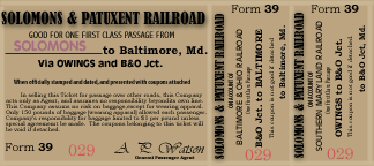
In S&P's 1936, Chesapeake Beach and the Southern Maryland Railroad are hugely successful. The Chesapeake Brach hotels are sumptuous, elegant, and a favorite getaway and meeting place for the cream of Washington, DC business and political society. Passenger accommodations on the Southern Maryland RR, cater to this clientele with ex-PRR heavyweight cars maintained in immaculate condition. In addition, the success of the Southern Maryland RR and the "Beach" has brought influential men with money to invest to the county. Some of this money has found its way to the Solomons and Patuxent Railroad.
The story of the Southern Maryland and S&P Railroads goes back to 1902 when a group of Baltimore businessmen headed by Edwin Warfield, Frederick Smith, William C. Codd and Thomas Winans, purchased the Chesapeake Beach Railway. Warfield, Smith, and Codd had been sponsors of the original Washington and Chesapeake Beach Railway in 1891. All properties and rights in the Chesapeake Beach development were acquired with purchase of Chesapeake Beach Railway Company.
In addition, this group reached an agreement with the Baltimore & Ohio to provide through ticketing to Baltimore and Washington expanding the Southern Maryland's existing Hyattsville, Md. only service. Connection to the Baltimore & Ohio is at B&O Junction (formerly Chesapeake Junction) just north of the Southern Maryland Railroad station at Seat Pleasant, Md. With this infusion of new money, the hotels 'Chesapeake' and 'Patuxent' were completed at Chesapeake Beach in 1904.
In 1918, following World War I, person-to-person promotion in Baltimore and Washington business circles drew an increasing number of businessmen to use luxurious hotel facilities for meetings and conferences. Well-to-do Washingtonians and some Baltimoreans built summer homes in Chesapeake Beach. As time passed, members of Congress, as well as high-ranking members of the Federal government, became regular patrons of the hotels and other bayside attractions. The railroad was quick to provide every amenity to these customers, going so far as to add diner and sleeper cars to attract wealthier clientele from Baltimore with a late departing overnight service which arrived in Chesapeake Beach in the early morning hours. The sleeper and dining cars would layover after arrival allowing passengers leave train for the hotels at their convenience. In addition, heavy public promotion drew increased numbers of excursionists and resort guests, seeking relief from the hot and humid summer months in Baltimore and Washington.
In 1903, a syndicate of Calvert County businessmen, bankers, and landowners including Joseph C. Lore, Sr. and Harry M. Woodburn of Solomons; Warren Denton of Broomes Island; and Joseph C. Gray, Sr. and Goodman Goldstein of Prince Frederick, was formed to promote construction of a railroad in Calvert County and petition the Maryland General Assembly for a corporate charter.
The Maryland General Assembly responded by enacting legislation creating a corporate charter for The Solomons and Patuxent Railroad Company in the 1904 session.
Always on the lookout for attractive investment opportunities, the Southern Maryland Railroad proposed financial backing for construction of a line from Owings, Md. through the county seat at Prince Frederick to Solomons Island and offered favorable freight rates and a track connection at Owings to the Solomons and Patuxent group. Agreement was eventually reached that included provisions guaranteeing that The Solomons and Patuxent Railroad be owned, managed, and operated separately from Southern Maryland Railroad.
Two North-South routes were initially proposed - the first from Solomons through eastern and central Calvert county to Prince Frederick (the county seat) and thence to Owings, Md. and interchange with the Southern Maryland; the second along the Patuxent River plain to Lower Marlboro, thence to Owings, Md. and interchange with the Southern Maryland. The first route would provide freight service for the Solomons Island seafood packers and the central county tobacco growers as well as North-South passenger service to the county seat with connections to Washington and Baltimore at Owings. The second would provide freight service to the packing houses and tobacco shippers along the Patuxent River. The final plan was a compromise that established the first route as the mainline of the railroad and the second as a branch line from St. Leonard to Broome's Island and Lower Marlboro.
The newly chartered S&P purchased the Calvert County portion of an old right-of-way from the moribund Baltimore and Drum Point Railroad in late 1904. This right-of-way had been graded through the length the county before the Baltimore & Drum point encountered financial difficulties from which they never recovered. The purchase was funded by issue of Solomons and Patuxent Railroad company bonds and a private placement with the Southern Maryland Railroad.
Rail routes to the Washington and Baltimore markets for oysters substantially reduced packing and shipping costs due to much faster and timelier delivery than by Chesapeake steamboat. The Midwest oyster market was opened by more rapid delivery of fresh oysters by Class I railroads from Baltimore and Washington.
Connection to Upper Marlboro via the Southern Maryland provided greater access and lower transportation costs for the warehousing of tobacco crops pending the annual auctions.
The initial S&P stock offering was fully subscribed and construction started in Solomons with a railroad office, station, and maintenance facility just north of Solomons Island.
Though construction progress was initially slow, the main and branch lines were eventually completed and, even with a national economy experiencing continued difficulty, the S&P, with its primarily agricultural customer base, survived and over time began to evidence long-term prosperity.
Afterword